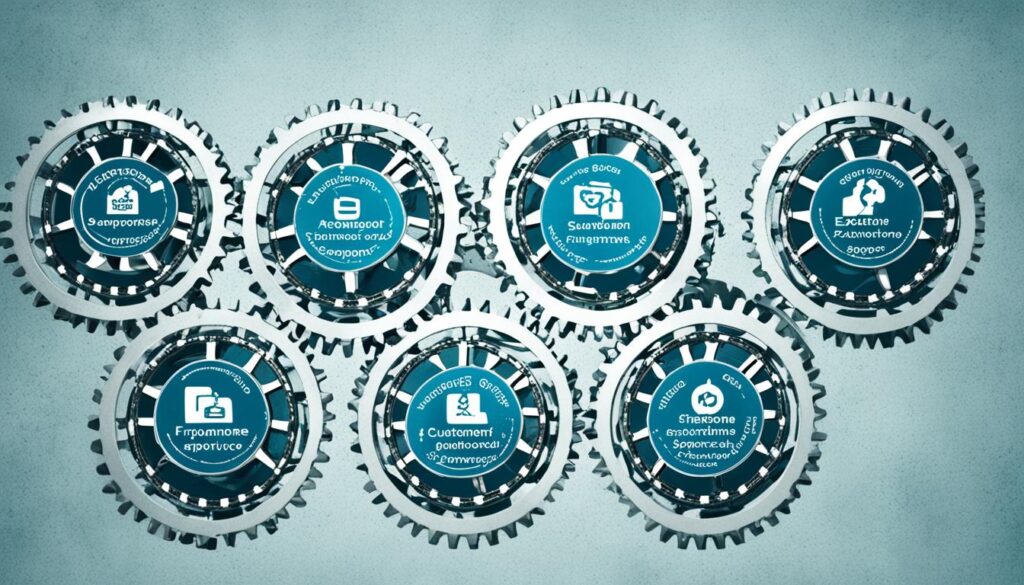Customer complaints matter a lot for any business. They can be key moments for turning things around. To deal with these situations effectively, businesses need a solid complaint handling plan. This article will explain how businesses can listen to their customers and use their feedback to grow stronger.
Key Takeaways:
- Handling customer complaints well is essential to keep customers happy and coming back.
- Having a clear system to resolve complaints can make customers feel heard and satisfied more quickly.
- A good complaint system can help turn customer issues into ways to improve and connect better with them.
- By solving complaints and turning bad feedback into good, companies can boost their image and make customers happier.
- By following the best steps for customer complaints, businesses can succeed more and grow.
Recognizing the Value of Customer Complaints
Customer complaints are more valuable than we think. Negative feedback can be off-putting at first. But it gives businesses a chance to do better. They can improve their products, services, and make customers happier.
Listening to complaints can help businesses find areas to work on. This way, they can improve their operations. And by meeting the customer’s needs, they can win their loyalty.
Opportunities for Improvement
Customers might complain about certain things they don’t like. By paying attention to these complaints, companies can learn. They’ll know what aspects of their products or services need fixing.
This knowledge can guide them to make their services better. And when they do, customers will enjoy their experience more. This leads to happier customers.
Complaints might point out bigger problems, like bad workflows. Fixing these problems can make the whole business run better. It also makes customers more satisfied.
Building Customer Loyalty
Solving customer complaints well shows a company cares. This makes customers trust the business more. They’re more likely to return for more and tell their friends good things.
Studies show happy customers become the best advertisers. They recommend the business to friends and family. This increases the business’s reach and its good reputation.
| Value of Customer Complaints | Improving Customer Satisfaction | Customer Loyalty | |
|---|---|---|---|
| Informs | Provides insights into areas of improvement | Identifies pain points and areas of dissatisfaction | Demonstrates commitment to customer satisfaction |
| Guides | Helps in making targeted improvements | Addresses underlying issues in business processes | Builds trust and fosters loyalty |
| Impacts | Enhancements to product offerings and customer experiences | Improves overall operational efficiency | Increases likelihood of repeat business and referrals |
Essentials of a Customer Complaint Handling Procedure
A good customer complaint system has key steps. It ensures problems are fixed well. Listening, apologizing, and solving issues fast are crucial. Businesses understand problems better when they listen hard. An apology shows they care and are working to fix the problem. Quick and right solutions make customers happy again. Let’s explore how to add these important steps to handling complaints.
Listening Actively to Customer Concerns
Good listening is at the heart of handling complaints. It means really focusing on what the customer says and seeing things from their view. Customer service reps should:
- Pay full attention and avoid being distracted
- Act like they really want to understand the issue
- Repeat or simplify what the customer said to make sure they got it right
- Ask questions that need more than a yes or no answer
- Always be polite and act professionally
Listening well helps build trust and makes customers feel heard. It starts the path towards fixing complaints.
Apologizing Sincerely When Necessary
A heartfelt sorry is sometimes all it takes. It shows that the company is ready to own up to its mistakes. When saying sorry, remember to:
- Admit to any errors openly
- Show you care in a real and kind way
- Avoid making excuses or pointing fingers
- Present ideas on how to make things right
Apologies can help a lot. They show the company is honest and caring. This can turn an unhappy customer into a satisfied one.
Providing Timely Solutions
Customers want their issues solved quickly. Late responses only make them more upset. To not keep customers waiting, businesses need to:
- Quickly acknowledge complaints with either a fast message or a real person
- Designate people to deal with complaints seriously
- Figure out what went wrong and what to do next
- Let the customer know how and when things will be solved
- Warn customers if things might take longer than expected
- Make sure to finish what was promised
Acting fast to solve complaints shows customers they are important. It helps keep them happy.

| Listening Actively to Customer Concerns | Apologizing Sincerely When Necessary | Providing Timely Solutions |
|---|---|---|
| Active listening skills enhance understanding of customer concerns. | Sincere apologies demonstrate accountability and commitment to resolution. | Timely resolutions restore customer satisfaction. |
| Give full attention | Admit mistakes and shortcomings | Acknowledge complaints promptly |
| Show genuine interest | Use a sincere and empathetic tone | Assign dedicated staff members |
| Verify understanding | Avoid making excuses or shifting blame | Investigate and gather information |
Setting Up a Complaint Management System
Businesses always want to give great service. Having a good complaint system helps a lot. It lets companies deal with customer issues fast and keeps customers happy.
This system helps businesses address customer issues step by step. It means they handle complaints well, make fewer mistakes, and make customers happier.
Importance of a Systematic Approach
Using a clear way to deal with complaints is key. It means setting up steps, knowing who does what, and making sure problems get fixed right.
With a clear method, businesses can:
- Make handling complaints the same every time
- Get rid of different ways problems are dealt with
- Get better at fixing issues quickly
- Help customers feel sure they can trust the company
A clear method also lets companies spot common issues. They can then improve their offerings and stop similar problems in the future.
Tracking and Documenting Complaints
Solving complaints is just the start. It’s also important to keep track of them. This info helps companies understand what their customers need and what goes wrong.
Keeping track of complaints includes:
- Writing down details of every problem, like what it was and when it happened.
- Using special codes to find complaints easily again.
- Watching how each problem is solved from start to finish.
- Looking at all the complaints to see any patterns of issues.
By keeping good records, businesses can find and fix hidden problems. This helps stop the same issues from happening again.
Having a good system for complaints, with clear steps and good record-keeping, is vital. It helps businesses make customers happier, keep them coming back, and always get better.
Empowering Your Team with a Customer Service Escalation Process
Empowering your team with how to handle tough customer complaints is key. They need training to face difficult situations. This includes learning skills and info to help customers well. It also means making sure everyone can talk to each other easily. This way, solving customer problems quickly becomes just part of the job. We’ll dive into why preparing your staff and setting up clear ways to talk are essential.

Training Your Staff for Effective Responses
Key to having a team that can deal with complaints is giving them the right training. Putting money into these programs lets your team build skills. They learn to truly understand the customer’s needs. Knowing your products well helps a lot too. Also, learning how to solve problems is a big part of the training.
Staff need to learn to really listen, solve conflicts, and stay upbeat in hard times. With these skills, your team can handle hard situations with care. They’ll get better at turning tough customers into happy ones.
Establishing Clear Communication Channels
Good communication is crucial for handling complaints. Customers want fast and right answers to their issues. By offering many ways to reach your team, you make it easier for them. This means phone, email, and chatting live are all good.
It’s also vital to set clear rules about how quickly you should reply. Being up front about when customers can hear back shows you care. Luckily, there are tools like customer relationship management software to help. They keep your team on top of all customer conversations.
Handling complaints well means good communication inside your company too. Makes sure everyone knows what to do if a problem gets really big. This way, no customer falls through the cracks. Teamwork ensures all complaints get quick and good attention.
By training your staff well and making it easy to communicate, your team is ready for any complaint. This makes customers happier and keeps them coming back. And it builds your company’s good name in the market.
Incorporating Empathy in Your Complaint Resolution Strategy
Empathy is key in handling complaints well and leaving customers with a good feeling. It involves understanding and being sensitive to how they feel. This way, businesses can not only solve issues but also build trust with customers.
It’s all about putting yourself in another person’s shoes. Imagine how they feel and act accordingly when solving their issue. This approach lets customers know that their problems are being taken seriously.
Active listening is a big part of showing empathy. When a customer is upset, really hear them out without cutting in. It makes a huge difference.
A sincere apology goes a long way. It shows you care and understand the customer’s feelings. Apologies help make customers feel like they matter.
Show you get why they’re upset. Use phrases like “I see why you’re frustrated.” It shows you’re on their side. This can calm them down.
Find a solution that fits the customer specifically. This shows you’ve really thought about their issue. It makes your efforts feel personal to them.
Always check back after solving the problem. This shows you’re serious about their happiness. It underlines a customer-first mindset in your business.
Being empathetic in handling complaints is not just about fixing problems. It’s about making customers feel heard and valued. Happy customers who feel understood often spread the word about your business. They become your best cheerleaders.
“Empathy is about standing in someone else’s shoes, feeling with his or her heart, seeing with his or her eyes.” – Daniel H. Pink
Effective Communication in the Customer Feedback Process
Encouraging Open Dialogue with Customers
Good communication is key in the feedback process. It helps businesses understand and fix customer problems. This leads to better products, services, and happier customers.
Encouraging customers to openly share is important. It makes them feel at ease to speak their mind. This sharing of opinions leads to ways for companies to get better.
Here are ways to make customers feel open to talk more:
- Give many ways to offer feedback. This can include email, phone calls, live chat, and social media. Let customers pick how they want to reach out.
- Always listen carefully. Whether it’s feedback or a complaint, show you care. This shows them you value their opinion and want to help.
- Make a safe area. Create a place without judgment to hear what customers really think. This means not reacting defensively or ignoring what they say.
- Ask questions if the feedback isn’t clear. Follow up to understand better. It shows you’re focused on helping and fixing problems.
Updating Customers on Complaint Status
Letting customers know about their complaint’s progress is very important. Being open keeps their expectations in check and builds trust.

Here’s how to keep customers up to date on their complaints:
- Be clear about updates upfront. Tell customers how often they’ll hear from you and do as you say.
- Tell them real news. When you update them, be specific and to the point. Don’t just say things that don’t mean much.
- Be honest if there’s a delay. Telling the truth about any issues is best. It makes your customers trust you more.
- If it takes long to fix, suggest something else. Maybe offer something as a way to say sorry for the wait. This can help keep them happy.
By promoting open talks and giving updates, companies can do better with feedback. Good communication means everyone wins.
Strategies to Resolve Customer Complaints
Handling customer complaints well is key to keeping them happy. By using smart strategies, businesses can fix problems fast. This leads to happy customers. Here are some tips:
- Active Listening: Listen carefully to what the customer is saying. Show you understand and care by responding in a thoughtful way. Make them feel heard and valued.
- Problem-Solving Techniques: Figure out what’s causing the issue. Then, work to find a solution that fits. This might mean looking into the problem or talking to different teams.
- Negotiation Skills: Sometimes you need to work out a solution together. It’s important to teach your team how to find fair answers that make everyone happy. Doing this can help you keep customers close.
- Offering Compensation or Remedies: For bigger problems, offer something to make it right. This shows you’re serious about customer happiness. You could offer money back, a new item, or a discount.
Using these steps in your business can turn complaints into chances to shine. Happy customers not only come back but also recommend you to others. This builds strong, loyal relationships with your brand.
Transforming Negative Feedback into Positive Outcomes
Negative feedback and complaints are chances for businesses to get better. They can look at what’s wrong and fix it. This way, they can stop the same problems in the future. Let’s talk about turning bad feedback into good changes by learning from mistakes.
Learning from Complaints
Customer complaints show businesses how they can do better. They highlight areas like products, services, and how customers are treated. Listening to complaints and understanding customers’ issues really helps businesses improve.
These complaints also show where there are problems in training or with the products. To really learn, businesses should:
- Look at complaints often to see if there are recurring issues
- Try to find the real causes of the complaints
- Get feedback from different parts of the company to fully understand the issue
- Keep track of what they learn and use this to make things better
Prevention of Future Issues
Dealing with complaints is important, but so is stopping future problems. By fixing the root causes of complaints, businesses can avoid the same issues later. Here are some ways to prevent problems:
- Put quality checks in place during production
- Train staff better for better service
- Improve how they communicate to solve problems faster
- Keep an eye on what’s new in the market and what customers want
By working on solving complaints and always getting better, businesses can stop issues from coming back. They also build stronger connections with their customers.
| Benefits of Learning from Complaints | Benefits of Preventing Future Issues |
|---|---|
| Identify blind spots in business operations | Create a culture of continuous improvement |
| Enhance product and service quality | Build customer trust and loyalty |
| Develop innovative solutions to customer pain points | Save resources by avoiding repeated complaints |
Creating a Positive Impact with Customer Support Complaint Procedure
Having a good customer support complaint system can boost how people see your brand. It’s vital for handling customer complaints well. This can make customers happier and build strong connections with them.
Impact on Brand Reputation
A well-handled customer support complaint system shapes how people view your brand. When customers feel like you’ve listened and solved their issue, they trust and often stick with your brand. Happy customers share their positive experiences, which helps your brand’s image.
But ignore or handle complaints poorly, and your brand might suffer. Bad experiences can easily spread online, making others wary of your brand. So, it’s key to have a good system to manage complaints and keep your brand’s image positive.
Heightened Customer Satisfaction
Satisfying your customers is key to success. A solid customer support complaint procedure can quickly and well resolve issues. Customers feel good when their problems are taken seriously and fixed with care and speed.
Happy customers stay loyal and often recommend your brand to others. This helps in keeping existing customers while attracting new ones. Good experiences also lead to positive feedback online, drawing more people to your business.
Overall, focusing on handling complaints well can greatly boost your brand’s image and keep your customers happy. It’s a fundamental way to build trust, improve your reputation, and encourage long-term customer loyalty.
| Impact of a Well-Implemented Customer Support Complaint Procedure | Benefits |
|---|---|
| Enhanced brand reputation | – Increased customer trust and loyalty – Positive word-of-mouth marketing |
| Heightened customer satisfaction | – Increased customer retention – Positive online reviews and recommendations – Improved customer acquisition |
Customer Complaint Handling Procedure: Best Practices
Using best practices for complaint handling is key in offering top-notch customer service and inspiring continuous improvement. It explains great methods that companies can use to make managing complaints easier and make customers happier.
For top-notch best practices for complaint handling, companies need to keep a few things in mind.
- Invest in regular training and development programs: Providing ongoing training to customer service reps is crucial. It gives them the right skills and expertise to handle complaints well. This training shines a spotlight on active listening, showing empathy, solving problems, and resolving conflicts.
- Solicit feedback from customers: It’s key to ask customers for their thoughts. Getting their feedback tells you about their experiences and where you can improve. Surveys, social media, and follow-up emails are good ways to do this. Using this feedback can help spot issues that keep coming up and take steps to stop them from happening again.
- Implement a culture of continuous improvement: Pushing employees to always get better keeps everything under the microscope. This means that processes and rules are constantly being looked at and refined. Making a work atmosphere that’s big on feedback and coming up with new ideas means that handling complaints gets better all the time. And this leads to offering outstanding customer service.
Following these best practices for complaint handling makes for a smoother, customer-focused complaint system. Not only does it solve problems but it also helps in making customers stick around and speak well of the company.

Conclusion
Dealing with customer complaints well is key for any business. It helps address customer concerns, build loyalty, and improve how the business runs. Recognizing complaints’ value and following key practices can change bad feedback into good results. Businesses that show empathy, communicate well, and follow best practices do better in solving complaints. This leads to a stronger brand, happier customers, and more success over time.
Responding quickly and professionally to complaints tells customers their opinion matters. By being attentive, businesses not only fix problems but boost their image too. It’s about listening, apologizing sincerely, and offering quick solutions. Doing this can turn unhappy customers into loyal fans.
Having a clear system to manage complaints means nothing falls through the cracks. This lets businesses track every issue, find patterns, and stop problems from happening again. By teaching their team to handle complaints well and keep communication open, businesses make sure problems get solved right the first time.
A great customer service process is essential for keeping customers happy, building trust, and encouraging constant improvement. Using the advice in this text, businesses can turn complaints into chances to get better and succeed.
